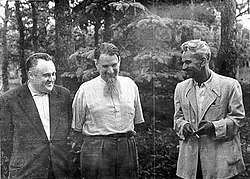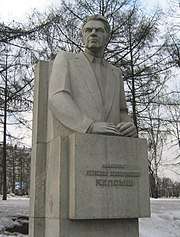Mstislav Keldysh
Mstislav Vsevolodovich Keldysh (Russian: Мстисла́в Все́володович Ке́лдыш; 10 February [O.S. 28 January] 1911 – 24 June 1978) was a Soviet scientist in the field of mathematics and mechanics, academician of the USSR Academy of Sciences (1946), President of the USSR Academy of Sciences (1961–1975), three times Hero of Socialist Labor (1956, 1961, 1971), fellow of the Royal Society of Edinburgh (1968). He was one of the key figures behind Soviet space program. Among scientific circles of USSR Keldysh was known with epithet "the Chief Theoretician"[1] in analogy with epithet "the Chief Designer" used for Sergey Korolyov.
Mstislav Keldysh | |
|---|---|
 Sergei Korolev (left), Igor Kurchatov (center) and Mstislav Keldysh (right) in 1956. | |
| Born | 10 February 1911 |
| Died | 24 June 1978 (aged 67) |
| Nationality | Soviet |
| Alma mater | Moscow State University |
| Awards | Hero of Socialist Labor (1956,1961,1971) |
| Scientific career | |
| Fields | Mathematics, mechanics |
| Institutions | Steklov Institute of Mathematics |
| Doctoral advisor | Mikhail Lavrentyev |
| Doctoral students | Sergey Mergelyan |
| Signature | |
 | |
Family
Keldysh was born to a professional family of Russian nobility. His grandfather, Mikhail Fomich Keldysh (1839–1920), was a military physician, who retired with the military rank of General. Keldysh's grandmother, Natalia Keldysh (née Brusilova), was a cousin of general Aleksei Brusilov. Keldysh's maternal grandfather, Alexander Nikolaevich Skvortsov, was a General of Infantry, and fought in the Caucasian War.
Keldysh's father, Vsevolod Mikhailovich Keldysh (1878–1965), was a civil engineer, Major General of the Engineering Service, and a full professor, teaching at the Kuybyshev Military Engineering Academy from 1918. He became a Distinguished Engineering Scientist of Soviet Union (Заслуженный деятель науки и техники СССР) in 1944. He was one of the authors of contemporary methods for calculating the strength of reinforced concrete, and a designer of the Moscow Canal and Moscow Metro projects.
Several members of the Keldysh family were victims of political repressions. In the 1930s Keldysh's uncle was sent to a labor camp on the White Sea–Baltic Canal construction site. In 1935 Keldysh's mother was arrested but was released after a few weeks. It was a part of the campaign of collecting gold from the population, but after Keldysh's father brought all the jewelry the family had, the unsatisfied NKVD officer returned "all this garbage" back. Keldysh's brother Mikhail, a historian who specialized in Medieval Germany, was arrested in 1936 and executed in 1937 on suspicion of being a German spy. In 1938 another of Keldysh's brothers, Alexander, was arrested as a French spy. Alexander was spared because of the slight liberalization of the repressions during the transfer of the NKVD leadership from Nikolai Yezhov to Lavrentiy Beria, and was acquitted in the court.
The strongest influence on Keldysh was his older sister, Lyudmila Keldysh (1904–1976), a mathematician and Keldysh's first teacher. Among her children are Leonid Keldysh, director of Lebedev Physical Institute and Sergei Novikov, a mathematician.
Biography

Keldysh was born in 1911 in Riga. When he was four the family evacuated to Moscow during the First World War. In the first years of the Soviet Union he was refused entrance to an Institute of Civil Engineers because of his attachment to a noble family. Later, he managed to enter and graduate from the Physics and Mathematics department of the Moscow State University. He obtained employment at the Central Aerohydrodynamic Institute (TsAGI) under Mikhail Lavrentyev and Sergey Chaplygin.
Working in TsAGI he explained the auto-oscillation effects of flutter (in-flight auto-induced oscillations and structural deformations), and shimmy (auto-oscillation in the nose-wheel of aircraft undercarriages while on the ground). The effects were responsible for many aircraft catastrophes at the time.
In 1937 Keldysh became Doctor of Science with his dissertation entitled Complex Variable and Harmonic Functions Representation by Polynomial Series, and was appointed a Professor of Moscow State University. In 1943 he became a Corresponding Member of the USSR Academy of Sciences. He got his first Stalin Prize in 1946 for his works on aircraft auto-oscillations. In 1943 he also became a full member of the Academy and the Director of NII-1 (Research Institute number 1) of the Department of the Aviation Industry. He also headed the Department of Applied Mechanics of the Steklov Institute of Mathematics. In 1966 the department was named after him to become the Keldysh Institute of Applied Mathematics.
During the 1940s Keldysh became the leader of a group of applied mathematicians involved in almost all large scientific projects of the Soviet Union. Keldysh created the Calculation Bureau that carried most of the mathematical problems related to the development of nuclear weapons. The bureau is also credited with design of the first Soviet computers. In 1947 he became a member of Communist Party.
Keldysh's main efforts were devoted to jet propulsion and rockets including supersonic gas dynamics, heat and mass exchange, and heat shielding. 1959 saw successful testing of the Soviet first cruise missile Burya, which displayed better performance than the Navajo missile being designed in USA at the time.
In 1954 Keldysh, Sergey Korolyov and Mikhail Tikhonravov submitted a letter to the Soviet Government proposing development of an artificial satellite to orbit the Earth. The letter was rejected, and the group filed exaggerated Soviet newspaper articles which influenced American authorities to start satellite programs. This in turn began the effort that culminated in the world's first satellite, Sputnik in October 1957, which marked the beginning of mankind's Space Age.[2][3][4] In 1955 Keldysh was appointed chairman of the Satellite Committee at the Academy of Science. In recognition of his contribution to the problems of defense Keldysh was awarded the Hero of Socialist Labor (1956) and the Lenin Prize (1957). In 1961 he received a second Него of Socialist Labor medal for his contribution to Yuri Gagarin's flight into space, the first person to orbit the Earth.
In 1961 Keldysh was elected President of the Academy of Sciences and kept this position for 14 years. Concomitantly he became a member of the Central Committee of the Communist Party of the Soviet Union. His last scientific works were devoted to creation of the Shuttle Buran. In 1962 he was elected a member of the Supreme Soviet of the Soviet Union.
Keldysh was 67 when he died. He was honoured with a state funeral and his ashes were buried in the Kremlin Wall Necropolis on Red Square.
Awards and honors
Keldysh was a member of many foreign academies of sciences, including the Mongolian Academy of Sciences (1961), Polish Academy of Sciences (1962), Czechoslovak Academy of Sciences (1962), and Romanian Academy of Sciences (1965). He was also an honorary member of the American Academy of Arts and Sciences (1966), Bulgarian Academy of Sciences (1966), Hungarian Academy of Sciences (1970), and Royal Society of Edinburgh (1968), foreign corresponding member of the German Academy of Sciences (1966), and Saxon Academy of Sciences in Leipzig (1966).
Keldysh was awarded the USSR State Prize (1942, 1946), Lenin Prize (1957), six Orders of Lenin, three other orders, numerous medals and four foreign orders.
The crater Keldysh on the Moon, and a research vessel Akademik Mstislav Keldysh are named after him. A minor planet, 2186 Keldysh discovered in 1973 by Soviet astronomer Lyudmila Chernykh, is named in his honor.[5]
A street (Akadēmiķa Mstislava Keldiša iela) has been named after Keldysh in the district of Pļavnieki in his native Rīga, Latvia.
See also
References
- Boris Chertok, Rockets and people Online version
- "Sputnik remembered: The first race to space (part 1) (page 1)". www.thespacereview.com. The Space Review. 2 October 2017. Archived from the original on 24 April 2019.
- Harford 1997
- "Sixty Years Later, Sputnik Declassifications Offer Primer in Fake News". Fordham Newsroom. Fordham University. 10 October 2017.
“In 1954 . . . because they knew a lot of Soviet journalists, they flooded the Soviet media with speculative articles on space flight .. cited a lot in the Washington Post and New York Times. July 1955, the Eisenhower administration announces they’re going to launch a satellite in a couple of years, it’s going to be a scientific satellite
- Schmadel, Lutz D. (2003). Dictionary of Minor Planet Names (5th ed.). New York: Springer Verlag. p. 178. ISBN 3-540-00238-3.
External links
| Wikimedia Commons has media related to Mstislav Keldysh. |
- Mstislav Keldysh at the Mathematics Genealogy Project
- (in Russian) Keldysh Institute for Applied Mathematics
- M. V. Keldysh memorial page (at Keldysh Institute site)
- (in Russian) Biography of Keldysh
- (in Russian) Keldysh's family
- (in Russian) Keldysh and Viktor Glushkov
- A.I. Ostashev, Sergey Pavlovich Korolyov - The Genius of the 20th Century — 2010 M. of Public Educational Institution of Higher Professional Training MGUL ISBN 978-5-8135-0510-2.
- "Bank of the Universe" - edited by Boltenko A. C., Kiev, 2014., publishing house "Phoenix", ISBN 978-966-136-169-9
- Mstislav Keldysh //Family history
- S. P. Korolev. Encyclopedia of life and creativity - edited by C. A. Lopota, RSC Energia. S. P. Korolev, 2014 ISBN 978-5-906674-04-3
- Harford, James (1999). Korolev: How One Man Masterminded the Soviet Drive to Beat America to the Moon. John Wiley & Sons. ISBN 0-471-14853-9. NASA segments
| Academic offices | ||
|---|---|---|
| Preceded by Alexander Nesmeyanov |
President of the Academy of Sciences of the USSR 1961–1975 |
Succeeded by Anatoly Alexandrov |